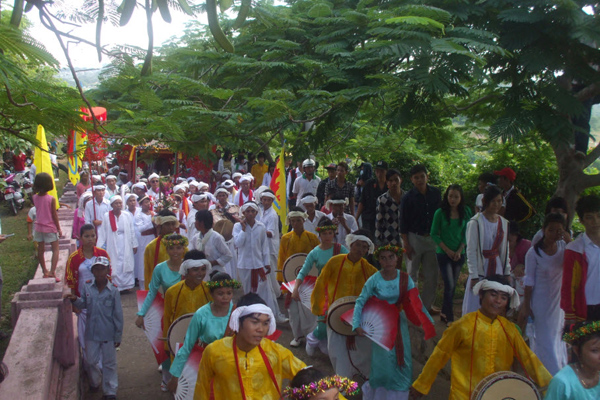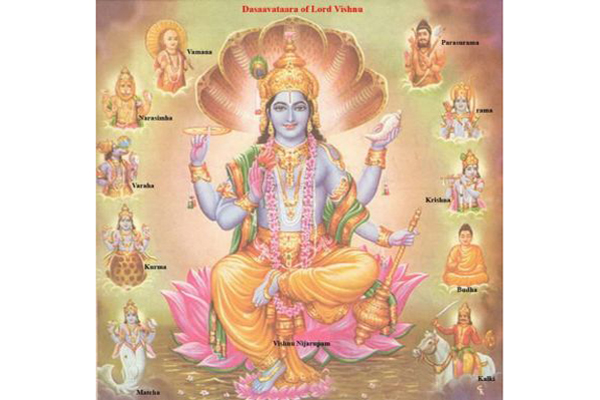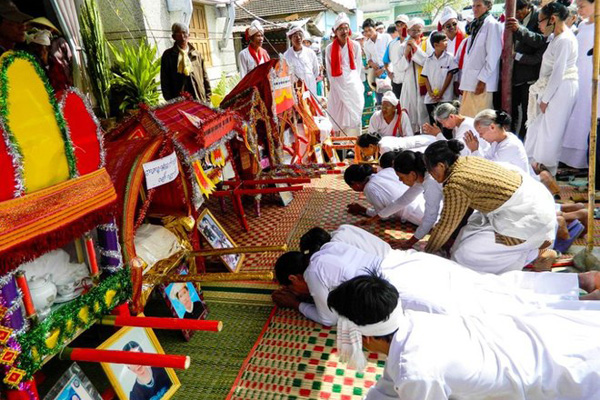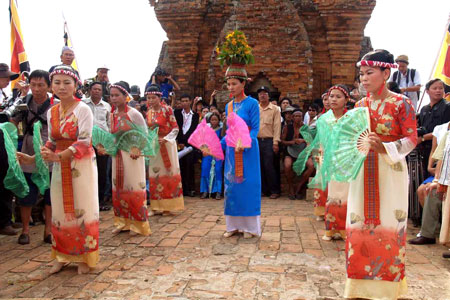In Vietnam, Brahmanism is only popular with the Cham people. The Cham are the people of the old kingdom of Champa, which was founded in the late second century and existed until the fifteenth century (192-1470). The kingdom lasted for three stages called Lam Ap (192-757), Hoan Vuong (758-874), and Chiem Thanh-Champapura (875-1470) and was ruled by seventy - seven kings. No matter whether the territory was expanded or narrowed, cloven or unified, it occupied the central coast of Vietnam, located between the 8° and 20° parallels. In terms of anthropology, the language of the Cham people belongs to the Malayo-Polynesian family. The Cham had a total population of more than 100,000 people, which put them in the fourteenth position among the fifty-four Vietnamese ethnic minorities in 2005. The Cham has a long, diversified culture and history, which is closely related to Brahmanism and Indian culture.

According to current knowledge, Indian religions spread into Southeast Asia in two ways: by sea and by land. People could depart from Coromandel (India) and sail through the Strait of Malacca to the Malay Archipelago. Alternatively, they could depart from Adsan to the Malay Archipelago, and then go through the Mekong Basin to Chenla and Champa.
Scholars believe that Indian religions spread into Champa very early. However, there is still uncertainty over the time and place of Brahmanical propagation in Champa. According to some Chinese historical documents and inscriptions, Brahmanism and Buddhism spread into Champa soon after the formation of the Cham government. Buddhism affected mainly the common people while Brahmanism had an influence on the upper classes of the court (kings and mandarins). In the end, Buddhism had to give way to Brahmanism. After the seventh century, Brahmanism, or the worship of Lord Siva, became the orthodox religion of Champa kings.
Similar to other ethnic groups in Southeast Asia, the Cham have an influential, age-old culture. Therefore, Brahmanism was localized by Cham people and became a different version in comparison with its original in India. That Brahmanism was reformed to become Hinduism in India, later on, did not have any impact on the Cham community following Brahmanism. Due to this difference the Cham, who followed Brahmanism, called themselves Cham Ahier or Cham Jat (original Cham). Nowadays, most Cham Brahmanists do not fully understand the Brahmanical tenets and canons. Generally, there are differences between Cham Brahmanism and Indian Brahmanism as follows:
Firstly, in terms of tenets and worship, Brahmanism traditionally worshipped Pham Thien (Lord Brahma) with the notion of "trimurti"-the triad of gods consisting of Brahma (the Creator), Vishnu (the Preserver) and Shiva (the Destroyer). However, Cham Brahmanists mainly worship Siva, whose characteristics are suited to their native culture. In their belief, Siva causes both destruction and regeneration. He destroys in order to regenerate, and he regenerates in order to destroy. His action results in a changing and developing universe. The Cham identify themselves with Shiva as they are particularly affected by the Vietnamese wet rice civilization. The Cham honour the Linga-Yoni symbol of Siva-the symbol of divine procreative energy, which over time has become an original characteristic of Brahmanism in Vietnam. As many as 300 gods are worshiped in traditional Brahmanism. However, Cham Brahmanists worship 117 gods, who are of either Indian or Cham origin. Among these 117 gods, there are some local matriarchal gods such as Po Inu Nugar-the Mother Country, Po Inu Nugar Murau-the Goddess of Ba Rau, and Po Inu Nugar Hamuram-the Goddess of Maram. The Cham calls the Brahmanical gods by names in the Cham language such as Po Ginuor Motri for Shiva, Kapil for Nandil-God Ox, Po Yan An Angin for Vayu -the God of Wind, Yang Apui for the God of Fire, and Atlitiak for the God of the Sun.

Secondly, in terms of religious ceremonies and practices, traditional Brahmanism respects religious rites connected to families and the community. During the year, there are hundreds of religious ceremonies. The dignitaries have to memorize sacred texts and practice a series of complicated and abstract rites, movements, and incantations. In religious ceremonies, the Cham attaches special importance to the rites that help them to achieve four goals: Dharma (duty and moral standards), Artha (wealth and prosperity), Kama (love), and Moksha (release). There are as many as forty rituals in the life cycle of a person.
Cham Brahmanists pay special attention to death rituals. In the traditional Brahmanism of India the dead are cremated. After three days the ashes and bones, which are not fully burnt, are collected and dropped into the Ganges River. After the cremation, only nine pieces of the dead person's frontal bone are collected and buried in a kut (tomb) under a stone stele.
An original feature of Cham Brahmanism is the construction of temples and towers, in which gods and kings of the ancient kingdom of Champa are worshipped. These structures are reminiscent of Indian architecture. In addition to the main temple (Kalan), there are many other temples and supporting structures. All structures of Champa face eastward, toward the rising sun, which symbolizes generation and proliferation-the functions of Siva. Cham temples and towers are built with refined brick, combined with rough sandstone blocks by a mysterious special adhesive mortar. Statues of gods and bas-reliefs carved into these structures, especially the charming Cham dancing girls, show the activities of the people during this period.
The dignitaries of Cham Brahmanism are affected by Indian Brahmanism's monastic institutions. Up to now, the dignitaries (Passeh) have held the highest positions in Cham society, even though divisions no longer exist within social classes. They are the intellectuals, who keep the Cham records and documents. They have a wide knowledge of the tenets, canons, rituals, customs, religious propagation and the performance of religious rites. The dignitaries' positions are transferred from fathers to children in the hereditary mode. No one else, however intelligent and rich they are, can join the ranks of dignitaries. There are five ranks of Cham Brahmanical dignitaries as follows:
- Passeh Dung Akauk is for the newcomers in the dignitary class;
- Passeh Liah is for the dignitaries who study Cham characters, tenets, canons, and sutras, and are trained in ritual performance;
- Passeh Tahwak (also called Feeding Priest) is for the dignitaries who do the feeding rites in funerals;
- Passeh Tapah (also called Pho Su ca) is for the dignitaries who have undergone all the strict conditions and attained enlightenment;
- Passeh Podhi (also called Su ca or Gru) is for the dignitaries who hold the highest positions and have supremacy in the rank of Brahmanical Passeh.
According to regulations, any person who wants to join and obtain a high position in the dignitary's rankings must undergo strict conditions and regulated ordination rituals.

Cham Brahmanical dignitaries dress in white with their hair kept in buns and hold magic sticks. The ranks of dignitaries are distinguished by the brocade patterns attached to their dresses and scarves. Dignitaries are allowed to get married, but they have to comply with strict rules. For example, they are not allowed to eat the animals relating to Cham fairy tales and sacrifices (such as bulls, eels, frogs, rabbits, and muntjacs) or those that died prematurely or from their wounds. They are also banned from eating papaws, pip bananas, figs, waxy pumpkins, and amaranth; drinking fermented liquids; attending the ceremonies of the human realm; sleeping with their wives on full moon days, on the first days of lunar months, and on Mondays and Fridays; or facing south during sleep. Finally, they have to squat during urination, bathe on particular days, and pray before eating or sleeping.
Besides Passeh, there are folk shamans such as Kain (male psychic), Muk rija (female psychic), Mudwon (who beats the paranung drum and sings odes), Muk pajau (who bathes the gods' statues and offers gifts), and Pariya hamu (who performs agricultural rituals). They dress in Cham traditional costumes and wear right-knotted bandanas.
Although the caste system no longer exists in the present Cham Brahmanical society, shreds of it are still manifested during funeral rites. In the Cham Brahmanical community, a dead person who belongs to a low-caste family has to have a small funeral and can only be buried, not cremated, however rich that person was. According to Cham beliefs, a dead person who is covered in the earth must go to hell. On the contrary, many poor people have big funerals thanks to their high-caste families.
According to the statistics of the Government Committee for Religious Affairs, there were 54,068 Brahmanists out of 200,000 Cham people, 192 dignitaries (including 15 Passeh Podhi and 10 Passeh Tapah), and 33 places of worship, including 19 temples and 6 towers (exclusive of My Son Holy Land, Quang Nam Province, which was recognized as a World Cultural Heritage by UNESCO).



